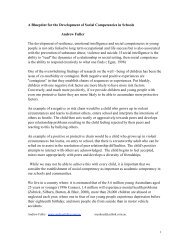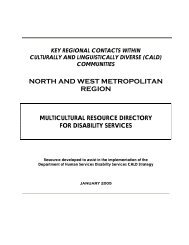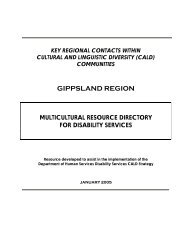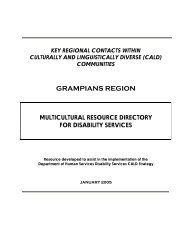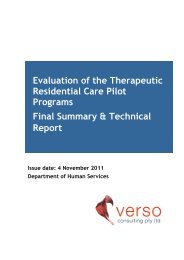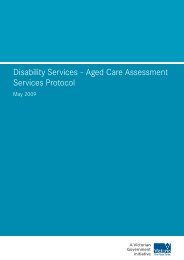Positive Behaviour Support - Department of Human Services - Vic ...
Positive Behaviour Support - Department of Human Services - Vic ...
Positive Behaviour Support - Department of Human Services - Vic ...
You also want an ePaper? Increase the reach of your titles
YUMPU automatically turns print PDFs into web optimized ePapers that Google loves.
54 <strong>Positive</strong> behaviour support: Getting it right from the start - Facilitators reference manual<br />
PowerPoint 74<br />
PowerPoint 75<br />
*<br />
*<br />
Individually list examples <strong>of</strong> how and why you communicated today.<br />
As a group identify the how and why the person you support communicated on your<br />
last shift.<br />
Are they different and why?<br />
About behaviours <strong>of</strong> concern<br />
Between five and 15 per cent <strong>of</strong> people with an intellectual disability show behaviours <strong>of</strong><br />
concern which can present a significant challenge to both the person and those involved in<br />
providing support.<br />
Of these only between two and 20 per cent <strong>of</strong> people in need <strong>of</strong> positive behaviour support,<br />
actually receive any kind <strong>of</strong> behavioural support. Fifty to 60 per cent <strong>of</strong> people with a disability<br />
showing behaviours <strong>of</strong> concern will be subject to the restrictive intervention <strong>of</strong> chemical<br />
restraint, which is psychotropic medication, typically antipsychotics, used for the primary<br />
purpose <strong>of</strong> behavioural control.<br />
<strong>Behaviour</strong>s <strong>of</strong> concern can be defined as:<br />
‘…behaviour <strong>of</strong> such intensity, frequency and duration that the physical safety <strong>of</strong> the person<br />
or others is placed or is likely to be placed in serious jeopardy, or behaviour which is likely<br />
to seriously limit use <strong>of</strong>, or result in the person being denied access to ordinary community<br />
facilities, services and experiences’. Emerson 1995<br />
Examples include:<br />
• aggressive behaviour<br />
• self-injurious behaviour<br />
• property destruction<br />
• fire lighting<br />
• withdrawn behaviour.<br />
The term ‘behaviours <strong>of</strong> concern’ implies that a higher standard and quality <strong>of</strong> services is<br />
required than those ordinarily provided to people with an intellectual disability. The behaviours<br />
that the term covers set a challenge to services to improve the way they do things. The term<br />
was first used to encourage service providers and the community to develop better services,<br />
supports and attitudes to address the behavioural difficulties demonstrated by some people with<br />
a disability. (Toogood, Bell, Jacques, Lewis, Sinclair and Wright, 1994).



